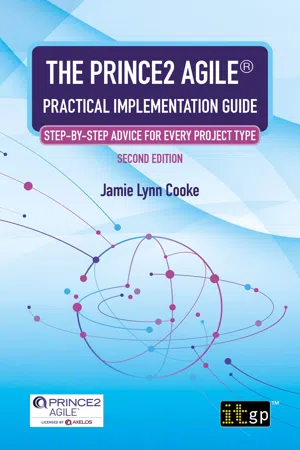
The PRINCE2 Agile® Practical Implementation Guide – Step-by-step advice for every project type
- 141 pages
- English
- ePUB (mobile friendly)
- Available on iOS & Android
The PRINCE2 Agile® Practical Implementation Guide – Step-by-step advice for every project type
About this book
The PRINCE2 Agile ® Practical Implementation Guide – Step-by-step advice for every project type, Second edition explains how the structured, management-driven PRINCE2 project governance framework can work cohesively with team-driven, quality-focused, responsive Agile methods.
This guide provides an overview of PRINCE2 ® and Agile before detailing the combined PRINCE2 Agile governance and project management framework. It also provides expert guidance on how to implement the PRINCE2 Agile framework in your organization, whether you have existing PRINCE2, Agile or waterfall structures in place, or you are implementing PRINCE2 Agile with no pre-existing frameworks.
The key to successfully implementing PRINCE2 Agile is understanding how it brings together PRINCE2 and Agile best practices into a cohesive framework, and how to adapt that framework to meet your organization's specific needs. This guide is structured to provide you with the core information that you need to understand how PRINCE2 Agile works, and implementation guidelines aligned to the needs of your organization and your projects.
Ideal for PRINCE2 Agile students, project managers, IT managers, senior managers, PRINCE2 users and Agile users, this guide will help you to successfully deliver high business value outcomes within the PRINCE2 Agile framework.
PRINCE2 Agile® is a registered trade mark of the PeopleCert group. Used under licence from PeopleCert. All rights reserved.
Frequently asked questions
- Essential is ideal for learners and professionals who enjoy exploring a wide range of subjects. Access the Essential Library with 800,000+ trusted titles and best-sellers across business, personal growth, and the humanities. Includes unlimited reading time and Standard Read Aloud voice.
- Complete: Perfect for advanced learners and researchers needing full, unrestricted access. Unlock 1.4M+ books across hundreds of subjects, including academic and specialized titles. The Complete Plan also includes advanced features like Premium Read Aloud and Research Assistant.
Please note we cannot support devices running on iOS 13 and Android 7 or earlier. Learn more about using the app.
Information
CHAPTER 1: OVERVIEW OF PRINCE2
Table of contents
- Cover
- Title
- Copyright
- Dedication
- Foreword
- Preface
- About the Author
- Acknowledgements
- Contents
- Introduction
- Chapter 1: Overview of PRINCE2
- Chapter 2: Overview of Agile
- Chapter 3: Overview of PRINCE2 Agile
- Chapter 4: Five keys to PRINCE2 Agile success
- Chapter 5: Step-by-step guidelines for all PRINCE2 Agile projects
- Chapter 6: Moving from PRINCE2 to PRINCE2 Agile
- Chapter 7: Merging Existing PRINCE2 and Agile Methods
- Chapter 8: Moving an existing waterfall project to PRINCE2 Agile
- Chapter 9: Implementing PRINCE2 Agile with no existing framework
- Chapter 10: Moving from Agile to PRINCE2 Agile
- Chapter 11: Further expansion of PRINCE2 Agile
- Bibliography
- Further reading